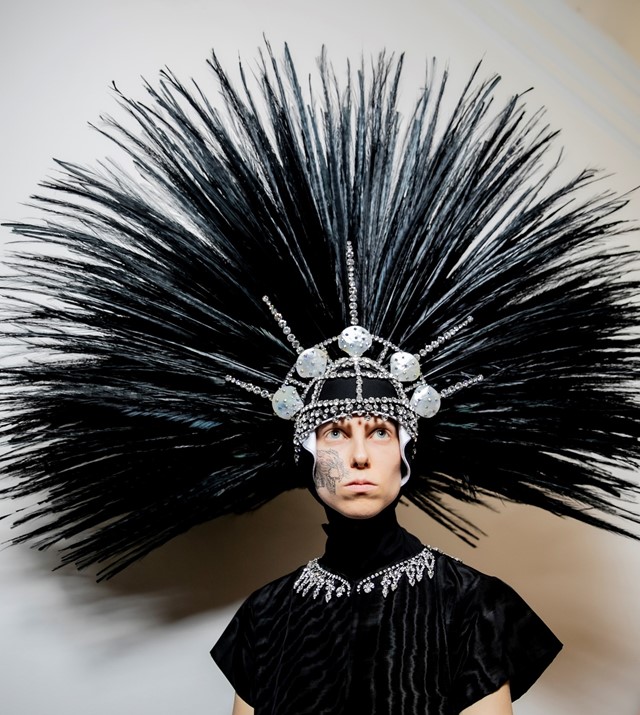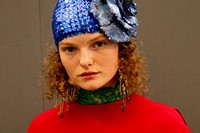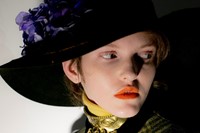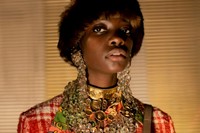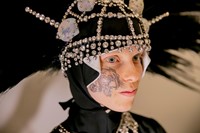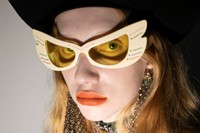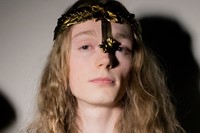Among the ancient artefacts of Rome’s Capitoline Museum, Michele showed a collection which was defiantly pro-choice
Rome – the ‘Eternal City’, as Ovid deemed – has a history which spans 28 centuries. In a single city block you might wander through several at once, tangled spectacularly in the architecture – the Imperial, the Baroque, the Neoclassical all jostle for a tourist’s attention. Beneath your feet, more history still: there lie the remains of the city’s Etruscan beginnings, fated to remain forever dormant under the architectural treasures which have since been built on top. That early city – founded on the banks of the Tiber sometime in 750BC – was a sum of its parts, too, raised by emigrants from across ancient Europe, by traders, warriors and runaway slaves.
A fitting setting, then, for Alessandro Michele’s latest Cruise collection for Gucci, held in the city yesterday. His tenure as creative director has been defined by his own kind of epoch-surfing excess and eclecticism: in a single collection he has been known to leap between centuries, continents, and subcultures, sometimes in a single look – “I prefer to use my imagination than a car or a plane,” he told Susannah Frankel in AnOther Magazine S/S18. Rome is also home for Michele: he was born in the Italian capital, and continues to live and work there today (Gucci’s design headquarters are themselves in a history-steeped palazzo, designed by Raphael and his pupil Giulio Romano).
The setting of the show itself – following the ancient necropolis of Alyscamps, Arles where Michele showed his previous Cruise collection – was Rome’s Capitoline Museum, a complex of archeological museums designed by Michelangelo and first established in 1471 (it is considered the oldest museum in the world). Among Pagan treasures, Hellenic statues and Renaissance-era artworks attendees sat, armed only with a torch to illuminate the vast marble corridors, which were in near-complete darkness. “My work sometimes is like being an archaeologist. I discover things. Using a torch I discover things that hide in the darkness,” Michele explained afterwards.
Out of that darkness appeared the collection: like the city itself, it conjured both the sacred – gowns fashioned in the manner of Roman togas or gold-trimmed Byzantine robes; ornamental jewellery and lace; cloaked outerwear, evocative of papal vestments – and the profane, where sprays of showgirl feathers and Gucci-branded suspenders met Mickey Mouse-emblazoned guitar cases, sweaters and luggage. Other clothing seemed to evoke the milieu of Roman life, particularly of the 1970s, an era Michele returns to often – suede suiting, cord flares and draped blouson dresses had the kind of undone, bourgeois sensibility of the city’s upper classes.
Afterwards, Michele deemed the show a “hymn to freedom”. “It was really important to organise this show in Rome in a time when it’s important to glorify this place that is a place of freedom,” he elaborated. “All the beautiful things surrounding us from the Pagan world are connected to a freedom that has sometimes been threatened. I tried to place all the characters of my movie in the best possible surroundings where they are allowed to be free.”

What does freedom mean now? On a jacket, “My body, my choice”, a reference to the 1970s rally cry for early abortion rights; on another, “May 22, 1978”, the date in which abortion was legalised in Italy. And so Michele declared Gucci, a true Italian institution, defiantly pro-choice – historic, considering the proximity of the show to the Vatican just a few kilometres away across the Tiber. On Sunday, at the ‘Yes to Life’ anti-abortion rally in Rome, Pope Francis made the Catholic church’s position crystal clear: having an abortion was akin to hiring a “hitman”. In America, meanwhile, a slew of anti-abortion legislation has passed; in Northern Ireland, abortion remains illegal even as it is decriminalised in the south.
“What I’ve been reading in newspapers made me reflect on the fact that women have to be respected,” Michele said. “They should be able to choose what they want and terminating a pregnancy is not going to uproot the womb or the uterus.” The rolling news cycle meant several of the pieces in the collection were made responsively, some just 24 hours before the show. On one memorable gown, a uterus was embroidered in gleaming pailettes. “The uterus is a mysterious and wonderful part, we can imagine it with flowers, like a garden,” Michele said.
And it was the symbolic womb itself which wove Michele’s collection together, and then back to Rome. “It is a place that’s difficult to define, even if you’re born here,” Michele said. “Rome is a big womb and many things came out of it. I will disappear but Rome will remain. Places that have been here for ages will remain; saints and prostitutes.”
